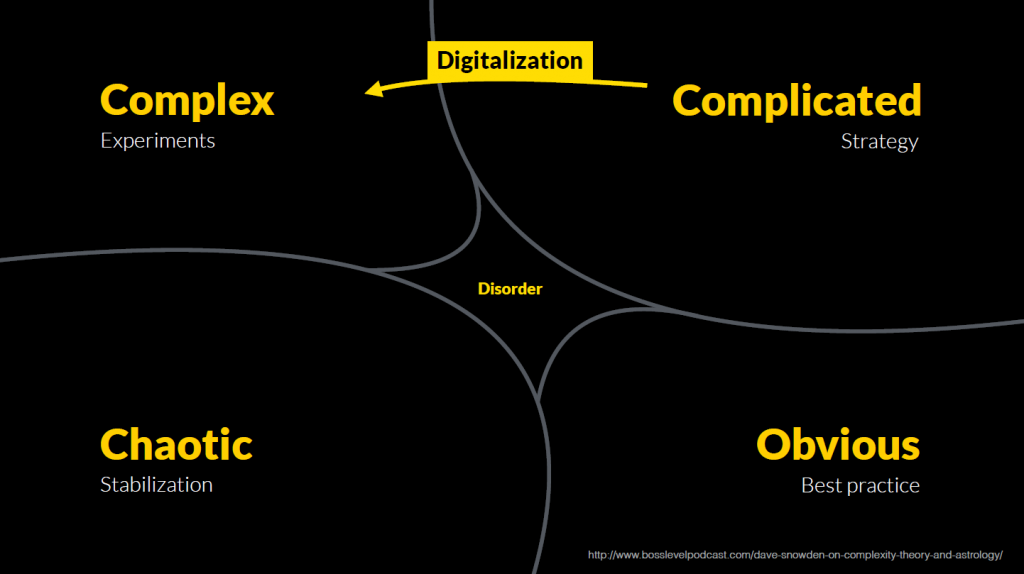
Build a Growth Business – Part 3: The Economies of Speed
9 Jun 2021 • Strategy & Business Design
They say that the only advantage of a fresh business is its speed. What does this argument mean, what is it based on, and how do you harness the speed of a fresh startup for your business? This is the third part of the blog series “Build a Growth Business” on the topic of the Economies of Speed.
The Operational Environment in 2021
It seems that whatever media you click open, the subjects always revolve around the New Normal, being hybrid, or scenarios. Let’s examine the operating environment of the new normal through this figure of Sami Honkonen below.

For years, the world has consistently progressed from a Complicated world to a very Complex world. However, some organizations are still trying to keep things the way they are by creating more processes and best practices. However, these “recipes for success” are primarily suitable for an operating environment that is Obvious and Repeatable.
In the past, the transition toward rapid experimentation was sold to companies under the name of digitalization, but only some bought the explanation (possibly due to too strong a technological tone). Last year, change was forced on companies through Covid. A term “Digitalization” could very well be replaced by “Pandemia” or “Hybridization” in Honkonen’s image. The former was not a matter of choice for companies and the latter is digitalization expressed more appealingly.
Hybridization is finally the thing that should make the rest of the organizations embrace the inevitable change.
Economics of Speed require several changes to the way you organize
The change mentioned in the previous chapter raises e.g. the following questions:
- If traditional strategy modeling is no longer enough, how should operations be managed?
- If
digitalizationCovid forces us to change “overnight,” how will this be made possible? - If the processes are no longer enough to guide staff, what should they be replaced with?
- One should move to a hybrid model, but what does it mean, and how to get there?
- Why is scenario modeling in fashion?
No matter what solution models a company chooses to utilize, everyone needs to increase their organizational clock frequency (Economies of Speed). It is a competitive advantage that it is (at least in theory) easier for a fresh company to harness for its use because there is no historical (organizational) ballast.
Which one steers the company: Personnel or management?
Somewhat 20 years ago, the answer was generally quite unambiguous: management directs the company. Today, for example, The organization model made famous by Supercell at the beginning of the 2010s, where small teams have large decision-making power, is becoming a standard. The utilization of the Economies of Speed can be boosted, for example, with the following elements:
- Purpose of the company’s existence
- Transparency (as radical as possible)
- Splitting responsibility and decision-making power more evenly
- Steering the organization with delicate flock intelligence
- Ecosystem-driven way of perceiving and utilizing the operational environment
- Utilizing digitality in core activities (eg hybridization)
- Culture of trial and error
- A reboot of learning skills
Each of the aforementioned themes is so extensive that one could write entire books about them (and, of course, there already exists a good bunch of them), so let’s go these through swiftly with the help of some examples.
The Purposes of the Organization
Let’s start with the purpose of the organization. I ignore the motivation aspect (self-evident) and focus on the steering effect of the strategy as a guide.
Modern strategy is not a plan. It is a behavioral model tailored for an organization to systematically finds sufficiently good answers before the competition.
Since the time-horizon organizations can see and manage becomes shorter year by year, also the need to be able to react increasingly faster becomes more evident. Agile methods carried companies from the world of waterfall (over)planning to the world of taking two-week spurts. But what is needed now is a mental leap to the world of “Post-Agile” to ensure value creation.
Agile methods can be taken to a whole new level if they are connected correctly to the OKR model, for instance, in order to make strategy and grassroots level operations communicate more efficiently. Another great model familiar from the SaaS world is product-led growth, and a third one is customer value management.
The Economies of Speed require “Post-Agile” methods that focus on generating value.
The Economies of Speed: Learn in the right way
In school, at least I have been conditioned to avoid mistakes by all means. There were only right and wrong answers in the exams. In other words, either “I succeeded” or “I failed”. This “pass or fail” model instilled into our minds is as inconsistent as possible with today’s growth-business environment, and un-learning it took several painful years.
The goal of a growth company is to test the solutions quickly and concretely, and based on the feedback, interpret whether they are going (sufficiently) in the right direction. There are no wrong answers because if done correctly, every experiment is an investment in finding the right path.
For fast learning to take place in a company, a few things are required: transparency (as radical as possible) and an effective model of reflection. People have to dare to fail in public, which requires quite a bit of trust. In addition, everyone’s self-esteem (especially of more experienced people) should tolerate the fact that even a newcomer can come up with a better solution in a second. The main thing is that someone discovers the solution.
A long CV combined with a “pass or fail” learning model may contradict strongly with achieving the Economies of Speed.
Flock Intelligence and Flock Direction
It would be good to harness the know-how of the whole organization with the help of flock intelligence and direction to speed up learning. By flock direction, I mean a group that reflects from its colleagues as a matter of routine. Self-direction is, in fact, a rather non-descriptive term because soloing is ill-suited to business. Winning is a team sport.
By flock intelligence, I mean systems and models in which all the know-how of the staff is available to any person in the company on an “as-a-service” basis. Flock-intelligent models are undergoing a major transformation, and for instance, the continuous machine-learning modeling of the staff skills and placing this data behind a search box is the latest trend.
From where the power of the flock ends, the ecosystem continues. How can the surrounding networks help our business? Platform economy and API-first thinking are just examples of ways in which virality or networking effects can be achieved. There are almost 20 different factors affecting network effects, one of them being the natural language, for example. The possibilities are thus almost endless and mainly depend on getting familiar with the subject.
One thing is certain: an active ecosystem accelerates learning.
Is the importance of speed overemphasized?
As you read this article, it might have occurred to you that there are also competitive factors other than speed. True, but the vast majority (if not all?) are only accessible to a few (e.g. the Economies of Scale). Secondly, the importance of speed and adaptability has been emphasized – last year explosively. Third, making more effective use of digitality as part of business is one of the keys for increasing speed.
For example, one recent trend in e-commerce is Q-Commerce, or Quick Commerce, which is defined on the Delivery Hero website as follows: “Q-Commerce brings small quantities of goods to customers almost instantly, whenever and wherever they need them.” The path that Amazon has paved is currently being traversed by the entire food transport industry, and others will undoubtedly follow. In addition, the measure of consumer perception for speed is global.
Another theme is Developer Velocity, meaning the ways in which an organization empowers software developers to add value to operations by removing “friction” from development processes. As one might expect, the capabilities of integration interfaces (API:s) as well as flexible development and testing environments are relevant. According to McKinsey, increasing the speed of development will result in 4-5 times faster revenue growth at best.

p.s. In the article photo, one Sofokusian shows an example of how to hybridize in the happiest country in the world during summer. Have a great June everyone! 😊
Shortcuts
- The Operational Environment in 2021
- Economics of Speed require several changes to the way you organize
- Which one steers the company: Personnel or management?
- The Purposes of the Organization
- The Economies of Speed: Learn in the right way
- Flock Intelligence and Flock Direction
- Is the importance of speed overemphasized?






